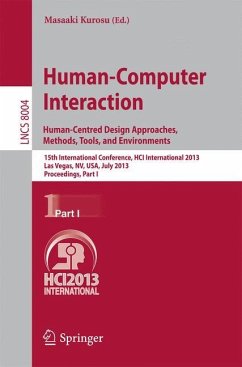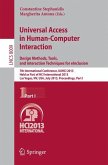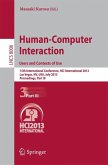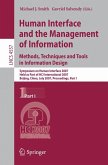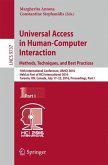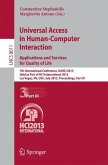Human-Computer Interaction: Human-Centred Design Approaches, Methods, Tools and Environments
15th International Conference, HCI International 2013, Las Vegas, NV, USA, July 21-26, 2013, Proceedings, Part I
Herausgegeben:Kurosu, Masaaki
Human-Computer Interaction: Human-Centred Design Approaches, Methods, Tools and Environments
15th International Conference, HCI International 2013, Las Vegas, NV, USA, July 21-26, 2013, Proceedings, Part I
Herausgegeben:Kurosu, Masaaki
- Broschiertes Buch
- Merkliste
- Auf die Merkliste
- Bewerten Bewerten
- Teilen
- Produkt teilen
- Produkterinnerung
- Produkterinnerung
The five-volume set LNCS 8004--8008 constitutes the refereed proceedings of the 15th International Conference on Human-Computer Interaction, HCII 2013, held in Las Vegas, NV, USA in July 2013.The total of 1666 papers and 303 posters presented at the HCII 2013 conferences was carefully reviewed and selected from 5210 submissions. These papers address the latest research and development efforts and highlight the human aspects of design and use of computing systems. The papers accepted for presentation thoroughly cover the entire field of human-computer interaction, addressing major advances in…mehr
Andere Kunden interessierten sich auch für
![Universal Access in Human-Computer Interaction: Design Methods, Tools, and Interaction Techniques for eInclusion Universal Access in Human-Computer Interaction: Design Methods, Tools, and Interaction Techniques for eInclusion]() Universal Access in Human-Computer Interaction: Design Methods, Tools, and Interaction Techniques for eInclusion42,99 €
Universal Access in Human-Computer Interaction: Design Methods, Tools, and Interaction Techniques for eInclusion42,99 €![Human-Computer Interaction: Users and Contexts of Use Human-Computer Interaction: Users and Contexts of Use]() Human-Computer Interaction: Users and Contexts of Use42,99 €
Human-Computer Interaction: Users and Contexts of Use42,99 €![Human Interface and the Management of Information. Methods, Techniques and Tools in Information Design Human Interface and the Management of Information. Methods, Techniques and Tools in Information Design]() Michael J. Smith (Volume ed.) / Gavriel SalvendyHuman Interface and the Management of Information. Methods, Techniques and Tools in Information Design122,99 €
Michael J. Smith (Volume ed.) / Gavriel SalvendyHuman Interface and the Management of Information. Methods, Techniques and Tools in Information Design122,99 €![Design, User Experience, and Usability: Design Philosophy, Methods, and Tools Design, User Experience, and Usability: Design Philosophy, Methods, and Tools]() Design, User Experience, and Usability: Design Philosophy, Methods, and Tools42,99 €
Design, User Experience, and Usability: Design Philosophy, Methods, and Tools42,99 €![Cross-Cultural Design. Methods, Practice, and Case Studies Cross-Cultural Design. Methods, Practice, and Case Studies]() Cross-Cultural Design. Methods, Practice, and Case Studies41,99 €
Cross-Cultural Design. Methods, Practice, and Case Studies41,99 €![Universal Access in Human-Computer Interaction. Methods, Techniques, and Best Practices Universal Access in Human-Computer Interaction. Methods, Techniques, and Best Practices]() Universal Access in Human-Computer Interaction. Methods, Techniques, and Best Practices41,99 €
Universal Access in Human-Computer Interaction. Methods, Techniques, and Best Practices41,99 €![Universal Access in Human-Computer Interaction: Applications and Services for Quality of Life Universal Access in Human-Computer Interaction: Applications and Services for Quality of Life]() Universal Access in Human-Computer Interaction: Applications and Services for Quality of Life42,99 €
Universal Access in Human-Computer Interaction: Applications and Services for Quality of Life42,99 €-
-
-
The five-volume set LNCS 8004--8008 constitutes the refereed proceedings of the 15th International Conference on Human-Computer Interaction, HCII 2013, held in Las Vegas, NV, USA in July 2013.The total of 1666 papers and 303 posters presented at the HCII 2013 conferences was carefully reviewed and selected from 5210 submissions. These papers address the latest research and development efforts and highlight the human aspects of design and use of computing systems. The papers accepted for presentation thoroughly cover the entire field of human-computer interaction, addressing major advances in knowledge and effective use of computers in a variety of application areas.This volume contains papers in the thematic area of human-computer interaction, addressing the following major topics: HCI and human centred design; evaluation methods and techniques; user interface design and development methods and environments; aesthetics and kansei in HCI.
Produktdetails
- Produktdetails
- Lecture Notes in Computer Science 8004
- Verlag: Springer / Springer Berlin Heidelberg / Springer, Berlin
- Artikelnr. des Verlages: 978-3-642-39231-3
- 2013
- Seitenzahl: 664
- Erscheinungstermin: 10. Juli 2013
- Englisch
- Abmessung: 235mm x 155mm x 36mm
- Gewicht: 990g
- ISBN-13: 9783642392313
- ISBN-10: 3642392318
- Artikelnr.: 38485118
- Herstellerkennzeichnung Die Herstellerinformationen sind derzeit nicht verfügbar.
- Lecture Notes in Computer Science 8004
- Verlag: Springer / Springer Berlin Heidelberg / Springer, Berlin
- Artikelnr. des Verlages: 978-3-642-39231-3
- 2013
- Seitenzahl: 664
- Erscheinungstermin: 10. Juli 2013
- Englisch
- Abmessung: 235mm x 155mm x 36mm
- Gewicht: 990g
- ISBN-13: 9783642392313
- ISBN-10: 3642392318
- Artikelnr.: 38485118
- Herstellerkennzeichnung Die Herstellerinformationen sind derzeit nicht verfügbar.
HCI and Human Centred Design.- HCI Education in Brazil: Challenges and Opportunities.- Semiotics of Interaction: Towards a UI Alphabet.- Engagingdesign - Methods for Collective Creativity.- Toward a New Design Philosophy of HCI: Knowledge of Collaborative Action of "We" Human-and-Technology.- The Link between Inclusive Design and Innovation: Some KeyElements.- Tuning an HCI Curriculum for Master Students to Address Interactive Critical Systems Aspects.- Ageing and Innovation.- Understanding User Experience and Artifact Development throughQualitative Investigation: Ethnographic Approach for Human-CenteredDesign.- User Research for Experience Vision.- Analyzing Varying Environmental Contexts in Public Transport.- The Conceptual Model of Experience Engineering (XE).- User Centered Inclusive Design Process: A 'Situationally-Induced Impairments and Disabilities' Perspective.- Applying Contextual Design to Multiple Teams in Emergency Management.- Visualization and Evaluation for Experience Vision.- Confabulation in the Time of Transdisciplinarity: Reflection on HCI Education and a Call for Conversation.- Proposal for Experience Vision.- Collaborative User Experience Design Methods for Enterprise System.- Evaluation Methods and Techniques.- An Estimation Framework of a User Learning Curve on Web-Based Interface Using Eye Tracking Equipment.- A Grounded Procedure for Managing Data and Sample Size of a Home Medical Device Assessment.- Usability Guidelines for Desktop Search Engines.- Analyzing Face and Speech Recognition to Create Automatic Information for Usability Evaluation.- Linking Context to Evaluation in the Design of Safety Critical Interfaces.- Environmental Evaluation of a Rehabilitation Aid Interaction under the Framework of the Ideal Model of Assistive Technology Assessment Process.- Towards Ergonomic User Interface Composition: A Study about Information Density Criterion.- Human-Machine Interaction Evaluation Framework.- Supervisory Control Interface Design for Unmanned Aerial Vehicles through GEDIS-UAV.- Remote Usability Evaluation of Mobile Web Applications.- Design and Implementation of ErgoIdentifier: A Tool for Automated Identification of Websites Interaction Elements.- A Self-Evaluation Tool for Quantitative User Research within the digital.me Project.- Priming Categorization in a Card Sort.- User Interface Design and Development Methods and Environments Case Study for Experience Vision - Application for PC.- Using the Common Industry Format to Document the Context of Use.- V&V of Lexical, Syntactic and Semantic Properties for Interactive Systems through Model Checking of Formal Description of Dialog.- Formal Pattern Specifications to Facilitate Semi-automated User Interface Generation.- A Mobile Application Flow Representation for Mutual Understanding of IT and Healthcare Professionals.- Communicating Ideas in Computer-Supported Modeling Tasks: A Case Study with BPMN.- Semantic Execution of Subject-Oriented Process Models.- SpecialChallenges for Models and Patterns in Smart Environments.- Parallel Rendering of Human-Computer Interaction Industrial Applications on Multi-/Many-Core Platforms.- A Logical Design Method for User Interface Using GUI Design Patterns.- Developing Mobile Apps Using Cross-Platform Frameworks: A Case Study.- EMIL: A Rapid Prototyping Authoring Environment for the Design of Interactive Surface Applications.- Extending the Information of Activity Diagrams with a User Input Classification.- Patterns and Models for Automated User Interface Construction - In Search of the Missing Links.- Evaluation of User Interface Description Languages for Model-Based User Interface Development in the German Automotive Industry.- An Empirical Study on Immersive Prototyping Dimensions.- From Multicultural Agents to Culture-Aware Robots.- Visual Interfaces Design Simplification through Components Reuse.- Established and Innovative Facets of Interactive Prototypes - A Case Study.- Multi-level Communicability Evaluation of a Prototyping Tool.- Participatory Action Research in Software Development: Indigenous Knowledge Management Systems Case Study.- Enhanced 3D Sketch System Incorporating "Life-Size" and "Operability" Functions.- An Interface Prototyper Supporting Free Design ComponentsSpecification.- Structured Scenario-Based Design Method for Experience Vision.- Requirements for a Definition of Generative User Interface Patterns.- Characterizing Incidents Reporting Systems across ApplicationsDomains.- Method Format for Experience Vision.- Case Study for Experience Vision Designing Notebook PC.- Aesthetics and Kansei in HCI.- Investigating the Effects of Font Styles on Perceived Visual Aestheticsof Website Interface Design.- A Color Schemer for Webpage Design Using Interactive Mood Board.- Study on Effects of Text Decoration for a Text Based Communication Tool in Education.- Ease of Icon Processing Can Predict Icon Appeal.- Basic Study on Kawaii Feeling of Material Perception.- Centrality of Visual Aesthetics in the Online Context: An Assessmentand Empirical Evidence.- The Feeling of Kawaii Is a Function of Interaction.- Comparison of Kansei Information between Joyful and HappyExpressions in Dance.- Study of Kawaii-ness in Motion - Physical Properties of Kawaii Motion of Roomba.
HCI and Human Centred Design.- HCI Education in Brazil: Challenges and Opportunities.- Semiotics of Interaction: Towards a UI Alphabet.- Engagingdesign - Methods for Collective Creativity.- Toward a New Design Philosophy of HCI: Knowledge of Collaborative Action of "We" Human-and-Technology.- The Link between Inclusive Design and Innovation: Some KeyElements.- Tuning an HCI Curriculum for Master Students to Address Interactive Critical Systems Aspects.- Ageing and Innovation.- Understanding User Experience and Artifact Development throughQualitative Investigation: Ethnographic Approach for Human-CenteredDesign.- User Research for Experience Vision.- Analyzing Varying Environmental Contexts in Public Transport.- The Conceptual Model of Experience Engineering (XE).- User Centered Inclusive Design Process: A 'Situationally-Induced Impairments and Disabilities' Perspective.- Applying Contextual Design to Multiple Teams in Emergency Management.- Visualization and Evaluation for Experience Vision.- Confabulation in the Time of Transdisciplinarity: Reflection on HCI Education and a Call for Conversation.- Proposal for Experience Vision.- Collaborative User Experience Design Methods for Enterprise System.- Evaluation Methods and Techniques.- An Estimation Framework of a User Learning Curve on Web-Based Interface Using Eye Tracking Equipment.- A Grounded Procedure for Managing Data and Sample Size of a Home Medical Device Assessment.- Usability Guidelines for Desktop Search Engines.- Analyzing Face and Speech Recognition to Create Automatic Information for Usability Evaluation.- Linking Context to Evaluation in the Design of Safety Critical Interfaces.- Environmental Evaluation of a Rehabilitation Aid Interaction under the Framework of the Ideal Model of Assistive Technology Assessment Process.- Towards Ergonomic User Interface Composition: A Study about Information Density Criterion.- Human-Machine Interaction Evaluation Framework.- Supervisory Control Interface Design for Unmanned Aerial Vehicles through GEDIS-UAV.- Remote Usability Evaluation of Mobile Web Applications.- Design and Implementation of ErgoIdentifier: A Tool for Automated Identification of Websites Interaction Elements.- A Self-Evaluation Tool for Quantitative User Research within the digital.me Project.- Priming Categorization in a Card Sort.- User Interface Design and Development Methods and Environments Case Study for Experience Vision - Application for PC.- Using the Common Industry Format to Document the Context of Use.- V&V of Lexical, Syntactic and Semantic Properties for Interactive Systems through Model Checking of Formal Description of Dialog.- Formal Pattern Specifications to Facilitate Semi-automated User Interface Generation.- A Mobile Application Flow Representation for Mutual Understanding of IT and Healthcare Professionals.- Communicating Ideas in Computer-Supported Modeling Tasks: A Case Study with BPMN.- Semantic Execution of Subject-Oriented Process Models.- SpecialChallenges for Models and Patterns in Smart Environments.- Parallel Rendering of Human-Computer Interaction Industrial Applications on Multi-/Many-Core Platforms.- A Logical Design Method for User Interface Using GUI Design Patterns.- Developing Mobile Apps Using Cross-Platform Frameworks: A Case Study.- EMIL: A Rapid Prototyping Authoring Environment for the Design of Interactive Surface Applications.- Extending the Information of Activity Diagrams with a User Input Classification.- Patterns and Models for Automated User Interface Construction - In Search of the Missing Links.- Evaluation of User Interface Description Languages for Model-Based User Interface Development in the German Automotive Industry.- An Empirical Study on Immersive Prototyping Dimensions.- From Multicultural Agents to Culture-Aware Robots.- Visual Interfaces Design Simplification through Components Reuse.- Established and Innovative Facets of Interactive Prototypes - A Case Study.- Multi-level Communicability Evaluation of a Prototyping Tool.- Participatory Action Research in Software Development: Indigenous Knowledge Management Systems Case Study.- Enhanced 3D Sketch System Incorporating "Life-Size" and "Operability" Functions.- An Interface Prototyper Supporting Free Design ComponentsSpecification.- Structured Scenario-Based Design Method for Experience Vision.- Requirements for a Definition of Generative User Interface Patterns.- Characterizing Incidents Reporting Systems across ApplicationsDomains.- Method Format for Experience Vision.- Case Study for Experience Vision Designing Notebook PC.- Aesthetics and Kansei in HCI.- Investigating the Effects of Font Styles on Perceived Visual Aestheticsof Website Interface Design.- A Color Schemer for Webpage Design Using Interactive Mood Board.- Study on Effects of Text Decoration for a Text Based Communication Tool in Education.- Ease of Icon Processing Can Predict Icon Appeal.- Basic Study on Kawaii Feeling of Material Perception.- Centrality of Visual Aesthetics in the Online Context: An Assessmentand Empirical Evidence.- The Feeling of Kawaii Is a Function of Interaction.- Comparison of Kansei Information between Joyful and HappyExpressions in Dance.- Study of Kawaii-ness in Motion - Physical Properties of Kawaii Motion of Roomba.

